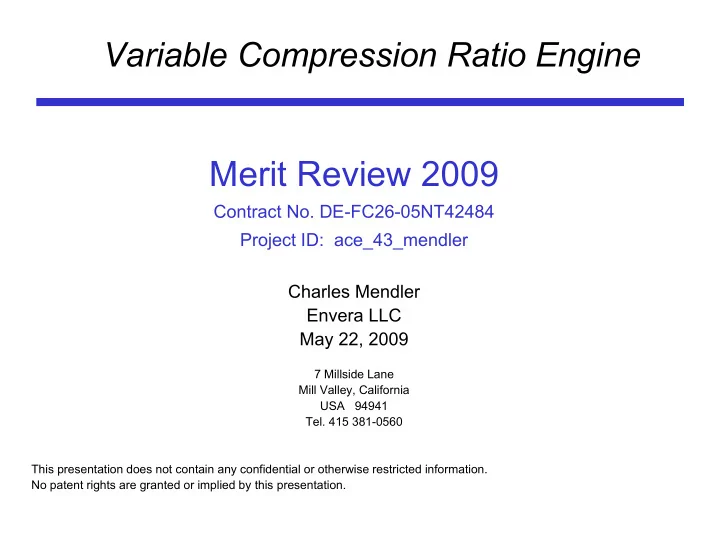

Variable Compression Ratio Engine Merit Review 2009 Contract No. DE-FC26-05NT42484 Project ID: ace_43_mendler Charles Mendler Envera LLC May 22, 2009 7 Millside Lane Mill Valley, California USA 94941 Tel. 415 381-0560 This presentation does not contain any confidential or otherwise restricted information. No patent rights are granted or implied by this presentation. File 041409
1 Variable Compression Ratio Engine Brief technology overview 2 Project Timeline, Budget and Barriers 9 Initial Approach / New Approach 10 Objectives 13 Milestones 14 Technical Accomplishments 15 Future Work 16 Program Summary 18 Appendix: Peer review Q&A 20 Publications and Critical Assumptions 33
2 Envera VCR Engine
18 3 Merit Review in Detail
4 RACK & PINION USED TO ADJUST CR Hydraulic cylinder Liner not shown The eccentric is turned +/- 16 o to adjust CR from 8.5 Control shaft to 18:1. The rack and pinion can be located vertically (shown) or Rack & Pinion horizontally in the oil plan. Links CONFIDENTIAL
5 COMPRESSION RATIO LOCKING Combustion pressure sensor in hydraulic cylinder. The link pins and control shaft axes are in-line. No force is transferred to the gears at maximum and minimum compression ratio. CONFIDENTIAL
6 Envera VCR Crankcase The crankcase is small, light and robust
7 Rigid VCR Crankcase Assembly FEA of VCR crankcase assembly
8 Merit Review
9 Timeline, Budget, Barriers Timeline – Project start January 19, 2006 – Project end date, tentative September 2009 – Percent complete 80% Total projected funding – DOE share $622,035 – Envera share $542,291 Technological barriers – A low cost fast response actuator is needed for variable compression ratio engines. The actuator needs to be reliable and efficient. Prior VCR actuators are costly and lack durability needed for commercial sales. A more efficient actuator is also needed in order to maximize the fuel economy benefits of VCR.
10 Initial Approach Initial approach – Piggy back the VCR hydraulic actuator system off of the transmission hydraulic circuit to minimize hardware cost and to minimize additional oil pump power consumption. – Implement a new intermittently high-pressure circuit to step-up the transmission oil pressure for powering the VCR.
11 Initial Development Results Initial Development Results: – Multi-body dynamic analysis results showed that hydraulic pressures would be higher than initially anticipated (~2250 psi). – Changes to the hydro-mechanical geometry will result in hydraulic pressures significantly lower than expected.
12 Major Finding and New Approach Major Finding and New Approach – The best pathway forward for attaining program success is to optimization of the hydro-mechanical design of the VCR mechanism /actuator to reduce hydraulic pressure requirements. – Attempt to lower hydraulic pressures enough through hydro-mechanical design changes so that a high- pressure loop is no longer needed, and ideally so that piggy-backing off the transmission is no longer essential for program success.
13 Objectives Reflecting New Approach Background In 2006/7 hydraulic feed pressures required for the VCR actuation system were reduced by 86% from ~2250 psi to ~314 psi largely through geometry changes. Past year objectives – Develop the integrated VCR actuator/crankcase system with the new mechanical geometry, and demonstrate that it is structurally sound using FEA analysis. – Rigorously adhere to low-cost manufacturing design principles when developing the new hydro-mechanical geometry.
14 Milestones FY 2008 – Design completed for VCR actuator system integrated into the crankcase. – FEA analysis of the VCR actuator system and crankcase completed, and indicating the hardware is robust and sound. FY 2009 – Rig test the new VCR actuator system, establish functionality, and record actuator response time vs. oil supply pressure. Project completed
15 Technical Accomplishments Prior work 86% reduction in hydraulic feed pressure requirements FY 2008 – Design of a low-cost VCR actuator/crankcase system embodying an optimized hydro-mechanical geometry. – Structural rigidity and durability needed for commercial production developed using FEA analysis.
16 Future Work Key Industry Commentary Now that the pressure is relatively low, use a dedicated hydraulic oil pump located on-board the engine so that: – The engines can be certified as fully functional coming off of the assembly line. – The hydraulic pump can be easily serviced or replaced. After the engine has been sold and proven out for a few years, then reconsider using pressurized oil from the transmission – for select applications.
17 Future Work FY 2009 Future work – Rig test the new VCR actuator system, and record VCR actuator response time vs. hydraulic oil feed pressure. Use an “on-board the engine” oil pump. Use compressed air to simulate rated loads on the actuator system. – Wrap up and complete the project in 2009.
18 Program Summary – Program objective : A low cost fast response actuator is needed for variable compression ratio engines. The actuator needs to be reliable and efficient. – Initial finding : Hydraulic pressures are too high, but can be greatly reduced through geometry changes. – New development approach: To meet the Program Objective, a new project approach was taken that focuses on hydro- mechanical design optimization. – Robust optimized hardware: A robust hydro-mechanical VCR actuator/crankcase system was designed using FEA analysis. – Project completion: Envera is on track for completing the project using rig testing in 2009.
19 ENVERA VCR www.VCREngine.com
Recommend
More recommend